In today’s world, the safe and secure transportation of hazardous materials is of paramount importance. Industries ranging from chemicals to pharmaceuticals rely on specialized packaging solutions to ensure that dangerous substances are handled and transported with the utmost care. One such essential tool in the world of hazardous material transport is the Flexible Intermediate Bulk Container (FIBC) bag. In this blog post, we will delve into the crucial role that FIBC bags play in ensuring safety during the transportation of hazardous materials.
Understanding Hazardous Materials:
Before we dive into the role of FIBC bags, let’s clarify what hazardous materials are. These substances can range from flammable liquids and toxic chemicals to infectious materials and radioactive substances. Transporting such materials poses serious risks to both human health and the environment, making it imperative to use the right packaging solutions.
The Anatomy of an FIBC Bag:
FIBC bags, also known as bulk bags or super sacks, are large, flexible containers made of woven polypropylene fabric. They come in various sizes and designs, but their primary purpose is to store and transport bulk quantities of materials. What sets FIBC bags apart from standard packaging is their ability to safely handle hazardous materials. Here’s how they do it:
1. Strength and Durability: FIBC bags are designed to withstand heavy loads. They are often reinforced with strong straps and seams, ensuring that hazardous materials are securely contained, even during transit.
2. Barrier Properties: These bags are made from materials that provide a barrier against moisture, UV radiation, and other environmental factors that could compromise the integrity of the hazardous substances inside.
3. Dust and Contaminant Control: FIBC bags are excellent at preventing the escape of hazardous dust or contaminants. This is especially important when dealing with materials that can be harmful when inhaled or exposed to the environment.
4. Static Electricity Dissipation: Many hazardous materials are sensitive to static electricity. FIBC bags can be manufactured with specialized features to dissipate static electricity, reducing the risk of sparks that could trigger an explosion or fire.
5. Easy Handling: FIBC bags are designed for ease of handling, often featuring lifting loops that allow for safe and efficient loading and unloading, minimizing the risk of accidents.
Compliance and Regulations:
When transporting hazardous materials, regulatory compliance is non-negotiable. FIBC bags used for hazardous materials must adhere to strict safety standards and certifications. These standards vary by country and industry, but they typically cover aspects such as design, testing, labeling, and documentation. Ensuring that FIBC bags meet these standards is crucial to guaranteeing the safety of both workers and the environment.
Applications of FIBC Bags in Hazardous Material Transport:
FIBC bags find applications in a wide range of industries, including:
- Chemical Industry: FIBC bags are used to transport various chemicals, including corrosives, flammables, and toxic substances.
- Pharmaceutical Industry: They are employed for the secure movement of pharmaceutical ingredients and hazardous waste.
- Agriculture: FIBC bags are used to transport fertilizers and pesticides safely.
- Waste Management: Hazardous waste disposal often involves FIBC bags to minimize risks during transportation and handling.
Conclusion:
In the realm of hazardous material transport, safety is non-negotiable. FIBC bags play a crucial role in ensuring that dangerous substances are securely contained, preventing leaks, spills, and exposure to the environment and workers. Their strength, durability, and compliance with stringent regulations make them indispensable tools in safeguarding our world from the potential dangers of hazardous materials. When it comes to transporting hazardous materials, remember: Safety First, with FIBC bags.
